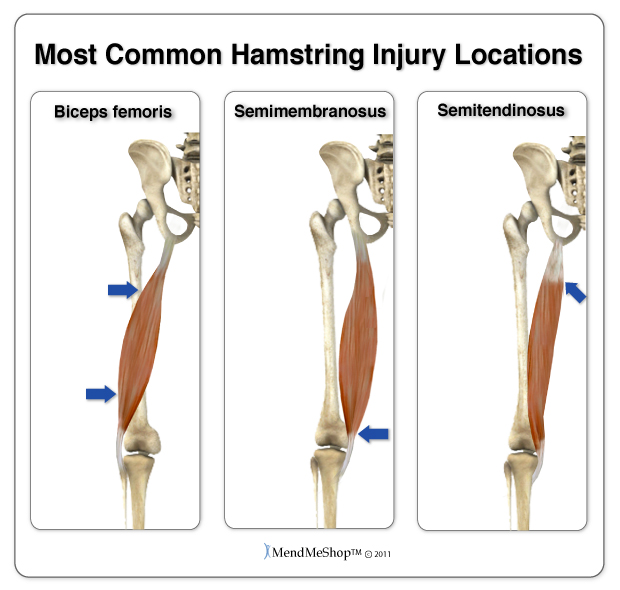|
| Hamstring Tendinopathy - Tendon Injuries of the Hamstring The biceps femoris hamstring muscle is the most frequently injured, as it suffers the largest stretch during sprinting, followed by the semitendinosus muscle. If you have a multi-muscle injury, it normally occurs at the point where your hamstring muscles and tendons meet (musculotendinous junction) at the top of the hamstring muscles. Hamstring Tendonitis and Tendinosis what is the difference?Hamstring tendonitis is inflammation (pain, swelling, warmth, redness and dysfunction) caused by tiny tears in one or more of the hamstring tendons located at the top of the leg around the ischial tuberosity and/or just below the knee, at the tibia or fibula. Hamstring tendinitis often leads to hamstring tendinosis over the long term.  The initial tendon damage can range from overstretching to partial tearing to complete rupturing of the small fibers that make up your hamstring muscles and tendons. If you do not allow your tissues to heal properly, your previous hamstring injuries will build upon each other. The inability of your tendon to repair itself encourages the microtears to accumulate faster than they can heal, increasing the degeneration in your tissue and reinforcing your pain and disability. Hamstring tendinosis is a chronic tendon injury that involves degeneration of the hamstring tendons. This type of tendinosis is a result of excessive tension, effort and/or repetitive use of your hamstring muscles and tendons. If you have hamstring tendonosis damage happens at a microscopic level - your tendon (which is made up of collagen fibers) becomes weaker and thinner over time and the hamstring tendon fibers begin to fray and separate. The tendon loses its glistening appearance and elasticity, and often changes to a soft texture that is yellow or brown in color (mucus-like appearance). Scar tissue or calcific deposits (calcium phosphate) develop around the injured area which can decrease the blood supply to the tissue. This condition can be in one or both of your legs and normally affects active people between 30 - 50 years old, especially distance runners, sprinters, tennis players, skaters, and soccer players (or those who participate in team sports with lots of running). Other conditions that are often seen with hamstring tendonitis are bursitis, rheumatoid arthritis or diabetes, avulsion fractures, stress fractures, and/or referred back pain. Symptoms of Hamstring TendinitisHamstring pain related to hamstring tendinitis will typically show up as an aching and stiffness which become more noticable first thing in the morning. You may feel weak in the knee and experience swelling in the thigh and calf muscles. You may feel a gradual pain in the back of the knee that will continue to get worse with activity. Hamstring tightness can lead to knee pain, hip pain, thigh pain, and even back pain.
Causes of Hamstring Tendinitis The most common cause of hamstring tendonitis is through overuse of the hamstring muscles. Sports that involve a lot of running and jumping or rapid changing of speed while running. Normally an injury as a result of overuse, hamstring tendonitis can also occur suddenly if the tendon becomes over stretched, such as when warm-up exercises or have been missed with a cold down after working out. As well over doing it with a workout or training to much-too-soon, causing the over-strain the hamstring when running, kicking, jumping or skipping movements. The hamstrings are not regularly used in common everyday motions like walking and standing. For people who are not very active, you may not notice if they have weak hamstring muscles, which leads to hamstring injuries. Diagnosis of Hamstring TendinitisA visit to your doctor is the best way to diagnose any type of hamstring / leg pain. To help your doctor achieve a proper diagnosis, he/she will begin with a medical history about you, your current condition and symptoms. He/she will inquire about the intensity of your present pain, the duration of your symptoms and the limitations you are experiencing. Details about what instigated the problem, when it started, and whether or not you have ever had treatments for this or a similar condition in the past, are very helpful in assessing your injury. Diagnostic testing may be ordered help discover your source of leg pain. Often used to rule out other conditions. MRIs (magnetic resonance imaging) will provide more detailed information and will help to evaluate the soft tissues in and around your area of pain (muscles, tendons, ligaments, and other connective tissues). It can identify ligament or tendon damage, and can help to determine the extent of your injury, the displacement and degree of your tear or inflammation, as well as other associated hamstring conditions. Hamstring Tendonitis TreatmentsHamstring injuries are frustrating to live with and healing can take a long time because it's difficult to give your leg the rest it needs. This is especially true for runners and other athletes that return to their sport too early. Re-injury is common but it prolongs recovery and may also lead to permanent damage and other conditions. Treating your hamstring tendon injury correctly is essential to getting rid of your pain and restoring function to your upper thigh, hip and knee. Proper treatment will get you back to regular activities sooner, stop your pain, and reduce the risk of future re-injury. Learn more about Hamstring Tendon Treatments by clicking here Product specialists are available 9:00 am to 5:00 pm Eastern Standard Time Monday to Friday. If any question or concern arises, call us or simply send us an email at any time (we check our emails constantly all throughout the day and night.. even on holidays!). We will respond as soon as possible. North America Toll Free 1-866-237-9608 |
    |

